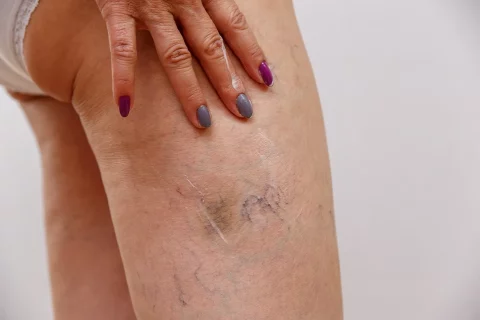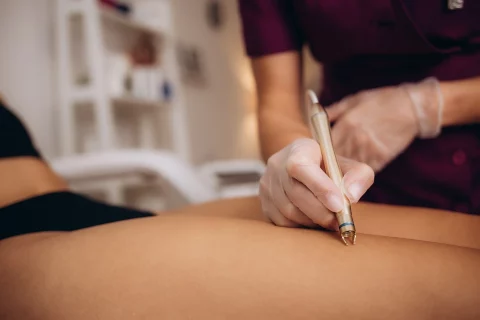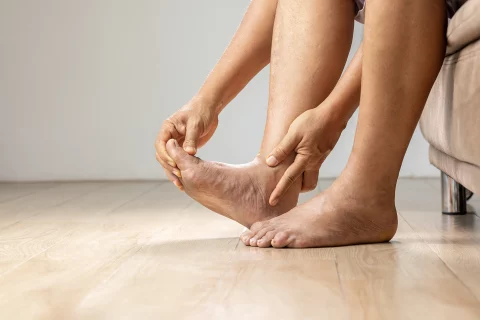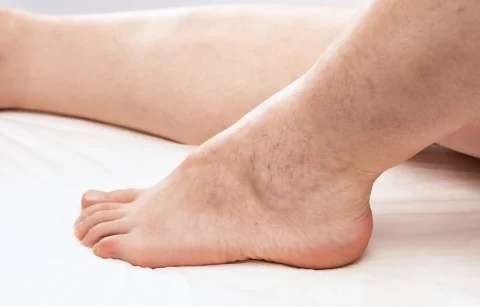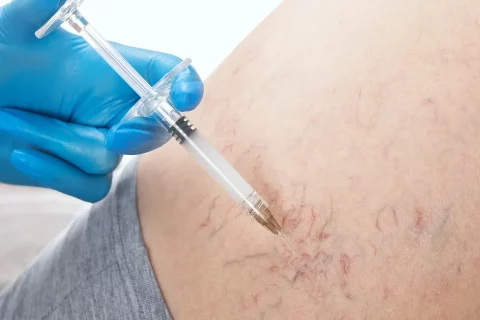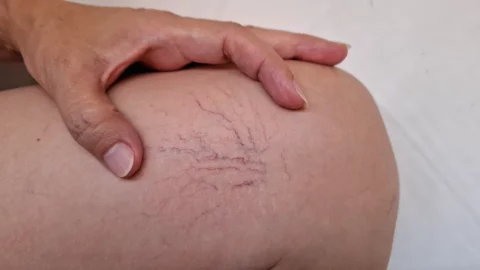The Healing Timeline: Weeks to Months After Treatment
Clearer legs without the distraction of spider veins? It sounds appealing. But what happens after the laser does its job? With every medical advancement comes a series of questions, concerns, and what-ifs.
This guide cuts through the clutter, offering a straightforward look at your post-treatment journey. Let’s demystify the process, step by step, so you can walk into the future with confidence.
Spider Vein Laser Treatment Explained
What is Spider Vein Laser Treatment?
Spider veins are those small, wispy blood vessels that appear primarily on our legs and sometimes on our faces. While they’re mostly harmless, they can be a cosmetic concern for many.
Enter spider vein laser treatment, a contemporary solution to address this issue. At its core, this treatment involves directing a focused beam of light at the spider vein. This results in clotting and ultimately leads the vein to dry up.
Over a period of about four to six weeks, our incredible body starts the process of reabsorbing this destroyed vein, leaving behind clearer skin.
Benefits of the Laser Treatment
It’s no wonder spider vein laser treatment has gained popularity in recent years. To begin with, it’s non-invasive, which is always a plus point when considering medical procedures.
The treatment is swift, with most patients reporting little to no discomfort. If you’re worried about taking time off work or daily activities, you’ll be pleased to know that the recovery time is minimal.
For those particularly pesky and delicate veins on your face, this treatment is an absolute boon.
Comparing Laser Treatment to Sclerotherapy
While spider vein laser treatment is a fantastic option, it’s essential to understand where it stands concerning other treatments. Sclerotherapy, for instance, is often touted as the gold-standard treatment for spider veins.
However, laser treatment is catching up fast as the second most popular choice for many patients. But here’s the catch: laser treatment shines when dealing with smaller spider veins. For larger varicose veins, this might not be the best option.
It’s always a good idea to consult with your provider about which treatment, or perhaps a combination of both, is right for your specific situation.
The Procedure of Spider Vein Laser Treatment
Setting the Stage for the Treatment
Spider vein laser treatment is designed for convenience and efficiency. One of the significant benefits is that there’s no need for a lengthy hospital stay.
In fact, many patients have their procedures done right in the healthcare provider’s office. A session typically wraps up in under an hour, making it possible for patients to head home shortly after the treatment is complete.
Understanding the Treatment Step-by-Step
- Safety First: At the onset, patients are provided with protective goggles. These are essential to shield the eyes from the laser’s intense light. After all, safety always comes first.
- Utilizing Doppler Ultrasonography: This might sound complex, but it’s a straightforward procedure. Here, the healthcare professional employs a device that emits sound waves to map out a clear image of the spider veins on a computer screen. This step ensures precision during the treatment.
- The Main Event – Laser Application: The healthcare professional will then target the laser directly over the spider veins on the skin. Some patients describe the sensation felt during the laser flashes as similar to a rubber band’s snap. Though brief, it can cause a bit of discomfort.
- Comfort Measures: To enhance the comfort level, patients are often offered ice during the treatment. It’s a simple yet effective way to mitigate any momentary discomfort.
Post-Treatment Care and Recovery
One of the standout features of this treatment is the minimal downtime. Once the procedure is done, it’s not unusual to notice some redness or soreness in the treated area. However, these symptoms are temporary.
To aid recovery, many healthcare professionals recommend wearing compression garments for a period after the treatment. This not only supports the treated area but can also enhance the overall results.
After a Spider Vein Laser Treatment, What Will My Legs Look Like When Healing?
Undergoing spider vein laser removal is a transformative experience for many. While the procedure itself is straightforward, it’s the post-treatment journey that often has patients curious.
Here’s a timeline of what you can typically expect in the days, weeks, and months following the treatment.
Immediate After-effects (0-48 hours post-procedure)
- Stay Active: It’s recommended that patients walk immediately after the treatment, usually between 30 to 60 minutes. This aids in circulation and promotes healing.
- Initial Discomfort: Some redness, irritation, or mild discomfort might be experienced right after the procedure. This is your body’s natural response to the treatment.
- Leg Care: Elevation of your legs for the first 48 hours can help alleviate discomfort. Also, it’s a good practice to wear a support hose for about 72 hours post-treatment for optimal recovery.
- Redness & Swelling: These are common immediate reactions. While it will be more noticeable in the first 24 to 48 hours, it might linger for some up to a week.
Short-Term Reactions (1-2 weeks post-procedure)
- Bruising: Your leg might show signs of bruising. However, these bruises are temporary and should fade within two weeks.
- Inflammation: Post-treatment inflammation is typical. This could manifest as red, swollen, and tender spots on your legs. Warm sensations in these areas are also normal.
- Tender Knots: Especially after an ambulatory phlebectomy, you might feel hardened, tender lumps in the treated areas. This is a standard part of the healing process.
Mid-Term Recovery (1 month to 6 weeks post-procedure)
- Continued Healing: A month in, the healing process is ongoing. You may still notice some swelling, but this will gradually reduce over the next few months.
- Visibility of Veins: The treated veins may still be noticeable, but rest assured, these will begin to fade over the next 3 to 6 weeks as the clotted blood within the veins dissipates.
Long-Term Recovery (6 months post-procedure)
- Full Recovery: By this time, most residual effects like numbness, discoloration, and any hardened areas should either have completely disappeared or significantly reduced.
It’s important to note that everyone’s body is unique. The exact timeline and intensity of these side effects will vary based on individual health and the specifics of the procedure.
5 Tips to Accelerate Healing After Laser Vein Treatment

Laser vein removal can be a game-changer for many individuals who are eager to banish those pesky spider veins from their skin.
While the procedure itself offers promising results, the real magic happens during the recovery phase.
To optimize and fast-track the healing process, consider integrating these five strategies:
- Limit Sun Exposure: Shielding the treated areas from direct sunlight is crucial for the initial two weeks post-procedure. UV radiation can intensify inflammation in blood vessels and lead to unwanted skin discoloration. When stepping out, ensure the treated skin is well-covered or protected with SPF.
- Elevate Your Legs: This simple act offers a multitude of benefits, reducing swelling and promoting efficient blood circulation. By keeping your legs raised, you’re offering them the best environment to heal smoothly.
- Stay Nourished and Hydrated: Fueling your body right plays an integral role in the healing process. Drink ample water and focus on a diet rich in bioflavonoids, which can help stave off further varicose vein formation.
- Pause High-Intensity Workouts: Taking a short break from strenuous exercises for about a week post-treatment ensures the treated veins remain undisturbed, allowing them to heal more effectively.
- Embrace Compression Stockings: These specialized stockings aren’t just a fashion statement. Wearing them for a duration of three to six weeks post-treatment can significantly support the veins, assisting blood flow and minimizing complications.
FAQs
What is the difference between spider veins and varicose veins, and how does their appearance change post-treatment?
Spider veins are smaller blood vessels that appear close to the skin surface, often resembling tree branches or web patterns.
Varicose veins, on the other hand, are larger veins that may bulge from the skin, appearing twisted and ropey.
After laser treatments, the appearance of spider veins generally fades faster than larger veins. However, both may require multiple treatment sessions for optimal results.
How soon can I resume normal activities and heavy lifting after undergoing spider vein treatments?
It’s advisable to refrain from strenuous activity and heavy lifting for at least a week post-treatment.
While you can resume daily activities shortly after the treatment, it’s essential to avoid any action that might strain the treated leg veins.
Consult your healthcare provider for specific guidance tailored to your medical history and treatment specifics.
Should I wear compression stockings after the treatment, and if so, for how long?
Yes, wearing compression stockings post-procedure is typically recommended. They aid in blood circulation by exerting pressure on the vein walls, promoting healthier veins.
Most patients are advised to wear them for about 3-6 weeks after treatment. However, the exact duration might vary based on your specific treatment and the guidance of your healthcare provider.
Will I experience pain after the procedure, and what can be done to alleviate it?
Mild discomfort might follow a laser vein removal session, though it’s usually tolerable.
Over-the-counter pain relievers can be effective, but it’s vital to consult with your health care provider before taking any pain medication. Applying cool packs and aloe vera gel can also soothe the treated areas.
Can direct sun exposure impact the healing process and appearance of my treated leg veins?
Yes, direct sun exposure can adversely affect the treated areas, potentially causing discoloration or inflammation in the healing blood vessels.
It’s recommended to shield the treated regions from direct sun for at least two weeks post-procedure. This measure ensures a smoother recovery and helps maintain the improved appearance of the treated veins.
Ready for Clearer Legs? Trust the Experts at Vein Center Doctor.

You don’t have to live with the discomfort or the appearance of spider veins.
With state-of-the-art treatments available, achieving smoother, vein-free skin is within your reach. Let the skilled professionals at Vein Center Doctor guide you towards a more confident tomorrow. Experience the blend of cutting-edge technology and compassionate care.


